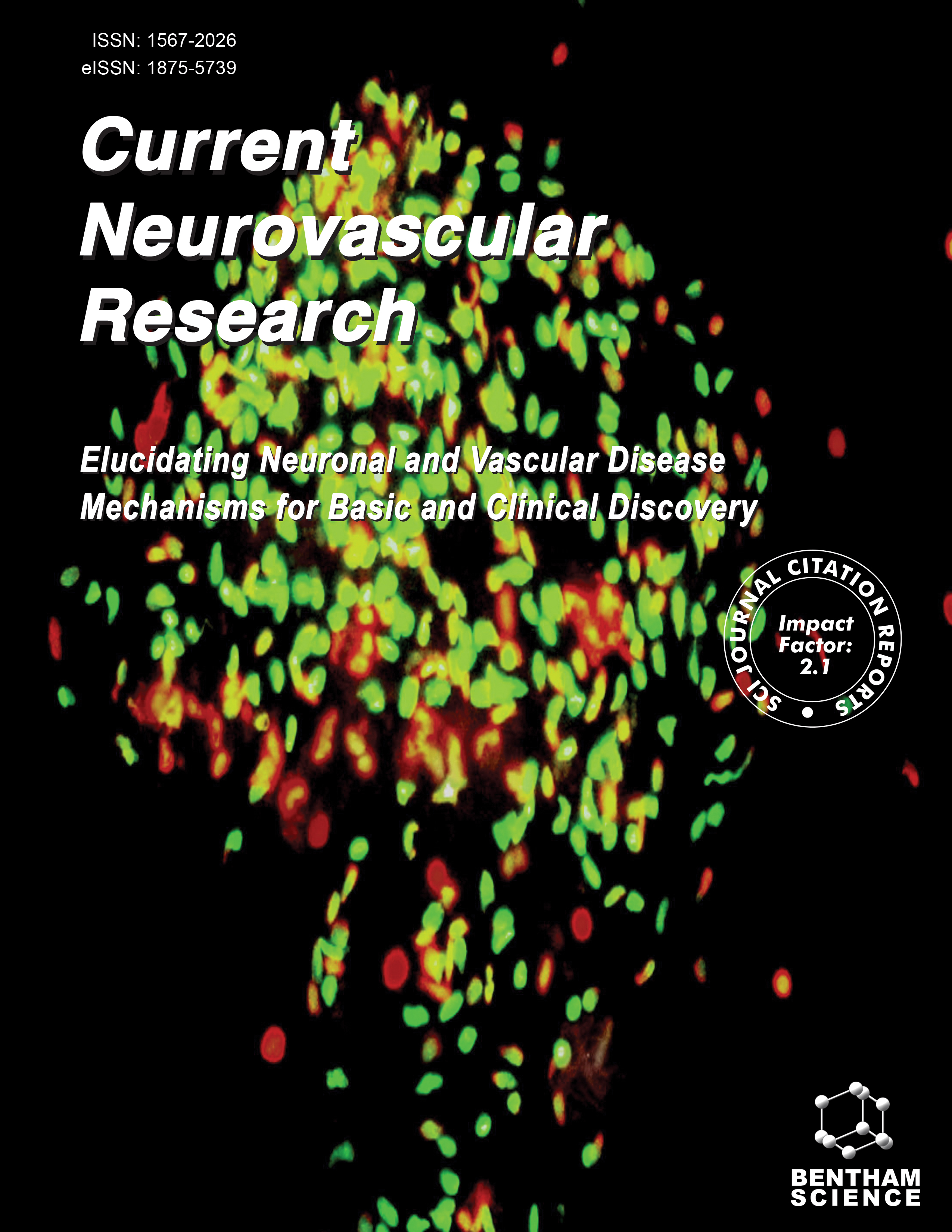- Home
- A-Z Publications
- Current Neurovascular Research
- Issue Home
Current Neurovascular Research - Current Issue
Volume 21, Issue 5, 2024
-
-
Microthrombosis at the Ultra-early Stages after Experimental Subarachnoid Hemorrhage Results in Early Brain Injury
More LessIntroductionEarly Brain Injury (EBI) significantly contributes to poor neurological outcomes and death following subarachnoid hemorrhage (SAH). The mechanisms underlying EBI post-SAH remain unclear. This study explores the relationship between serial cerebral blood flow (CBF) changes and neurological symptoms, as well as the mechanisms driving CBF changes in the ultra-early stages after experimental SAH in mice.Me Read More
-
-
-
Prognostic Value of Serum Bilirubin in Aneurysmal Subarachnoid Hemorrhage Patients
More LessAuthors: Ruoran Wang, Hongying Luo, Jianguo Xu and Min HeBackgroundBilirubin plays a crucial role in the pathophysiological processes of strokes. However, the relationship between serum bilirubin levels and the prognosis of aneurysmal subarachnoid hemorrhage (aSAH) remains unexplored. This study aims to investigate the association between serum bilirubin levels and the mortality rate of aSAH patients.Methods695 aSAH patients were included to analyze the relationship between dir Read More
-
-
-
Plasma Osteoprotegerin and Cognitive Impairment after Ischemic Stroke
More LessAuthors: Xinyue Chang, Pinni Yang, Yi Liu, Yu He, Xiaoli Qin, Beiping Song, Quan Yu, Jiawen Fei, Mengyao Shi, Daoxia Guo, Yanbo Peng, Jing Chen, Aili Wang, Tan Xu, Jiang He, Yonghong Zhang and Zhengbao ZhuBackgroundPlasma osteoprotegerin (OPG) has been linked to poor prognosis following stroke, but its impact on post-stroke cognitive impairment (PSCI) is unknown. The purpose of our work was to analyze the relationship of OPG with PSCI.MethodsOur study included 613 ischemic stroke subjects with plasma OPG levels. We used the Mini-mental State Examination (MMSE) and Montreal Cognitive Assessment (MoCA) to ass Read More
-
-
-
CT Perfusion Metrics as Indicators of Intracranial Atherosclerotic Stenosis in Acute Ischemic Stroke: A Clinical Analysis
More LessAuthors: Yunpeng Liu, Jumei Huang, Jianwen Jia, Yingting Zuo, Yang Wang and He LiuBackgroundIntracranial Atherosclerotic Stenosis (ICAS) is a prevalent etiology of acute ischemic stroke (AIS), leading to significant morbidity and mortality. The accurate diagnosis and treatment of ICAS-induced AIS are critical to improving outcomes. This study assesses the application of Computed Tomography Perfusion (CTP) in predicting ICAS in AIS patients and its potential impact on patient management.MethodsA retr Read More
-
-
-
Late Endovascular Treatment for Ischemic Stroke with Moderate to Large Infarct Volume is Associated with a better Clinical Prognosis
More LessAuthors: Peng Jiang, Sheng Zhang, Weitao Yu, Zongjie Shi, Xinzhao Jiang, Xu Wang, Longting Lin, Mark Parsons and Wenting GuoObjectiveThe concept of “time is brain” is crucial for the reperfusion therapy of ischemic stroke. However, the Infarct Growth Rate (IGR) varies among individuals, which is regarded as a more powerful factor than the time when determining infarct volume and its association with clinical outcomes. For stroke patients with a similar infarct volume, a longer time from stroke Onset to Imaging (OTI) correlates with a lower IGR Read More
-
-
-
Etiologies and Risk Factors by Sex and Age in Young Adult Patients with Ischemic Stroke
More LessAuthors: Linrui Huang, Yanhua Wang, Yanan Wang and Simiao WuAimThe aim of this study was to explore etiologies and risk factors by age and sex in young adult patients with ischemic stroke.MethodsWe recruited patients with ischemic stroke aged between 18 and 49 years. We assessed pathological etiologies by the Trial of Org 10,172 in Acute Stroke Treatment (TOAST) classification and risk factors by the International Pediatric Stroke Study (IPSS) classification. We explored the Read More
-
-
-
Basic Fibroblast Growth Factor-releasing Polyglycolic Acid Duras Improve Neurological Function after Cerebral Infarction
More LessAuthors: Yoshiro Ito, Ayako Oyane, Hideo Tsurushima, Yuji Matsumaru and Eiichi IshikawaObjectiveRegenerative therapy using stem cells to treat cerebral infarction is currently in the research phase. However, this method is costly. It also faces other significant challenges, including optimization of timing, delivery methods, and dosage. Therefore, more practical and effective therapies are required. Bioabsorbable artificial dura mater made from nonwoven Polyglycolic Acid (PGA) fabric is used clinically to treat cerebral i Read More
-
-
-
Nomogram Models for Predicting Poor Prognosis in Lobar Intracerebral Hemorrhage: A Multicenter Study
More LessAuthors: Yijun Lin, Anxin Wang, Xiaoli Zhang, Mengyao Li, Yi Ju, Wenjuan Wang and Xingquan ZhaoObjectiveWe aimed to investigate the prognostic factors associated with lobar intracerebral hemorrhage (ICH) and to construct convenient models to predict 3-month unfavorable functional outcomes or all-cause death.MethodsOur study included 322 patients with spontaneous lobar ICH from 13 hospitals in Beijing as a derivation cohort. The clinical outcomes were unfavorable functional prognosis, defined as a modified Rankin Read More
-
Volumes & issues
-
Volume 21 (2024)
-
Volume 20 (2023)
-
Volume 19 (2022)
-
Volume 18 (2021)
-
Volume 17 (2020)
-
Volume 16 (2019)
-
Volume 15 (2018)
-
Volume 14 (2017)
-
Volume 13 (2016)
-
Volume 12 (2015)
-
Volume 11 (2014)
-
Volume 10 (2013)
-
Volume 9 (2012)
-
Volume 8 (2011)
-
Volume 7 (2010)
-
Volume 6 (2009)
-
Volume 5 (2008)
-
Volume 4 (2007)
-
Volume 3 (2006)
-
Volume 2 (2005)
-
Volume 1 (2004)
Most Read This Month Most Read RSS feed
Article
content/journals/cnr
Journal
10
5
false
en


